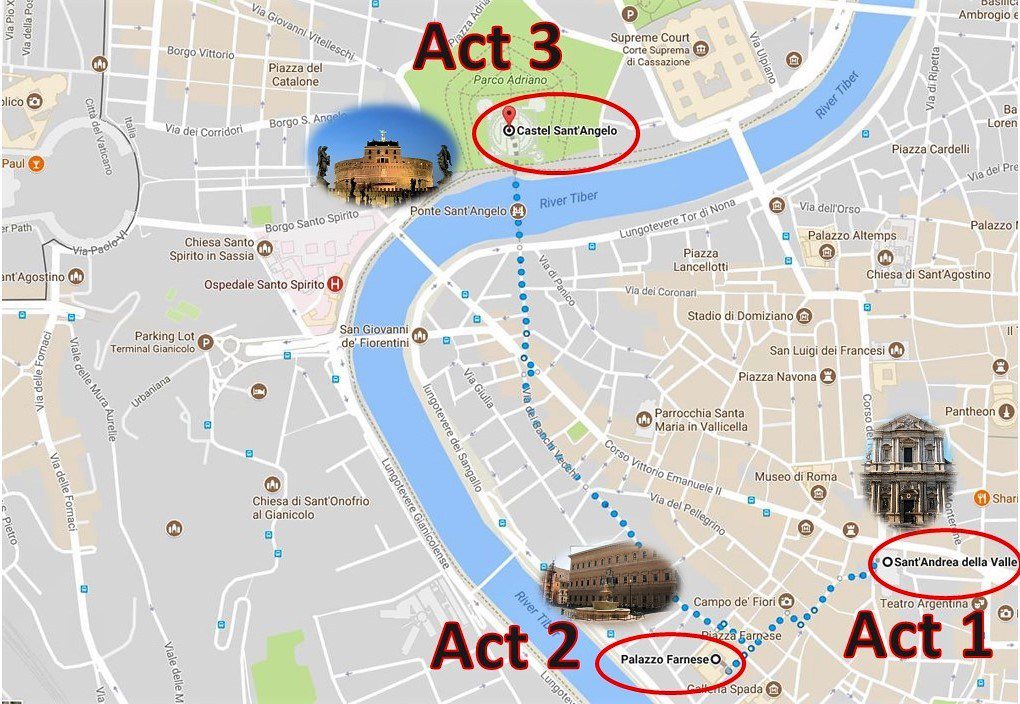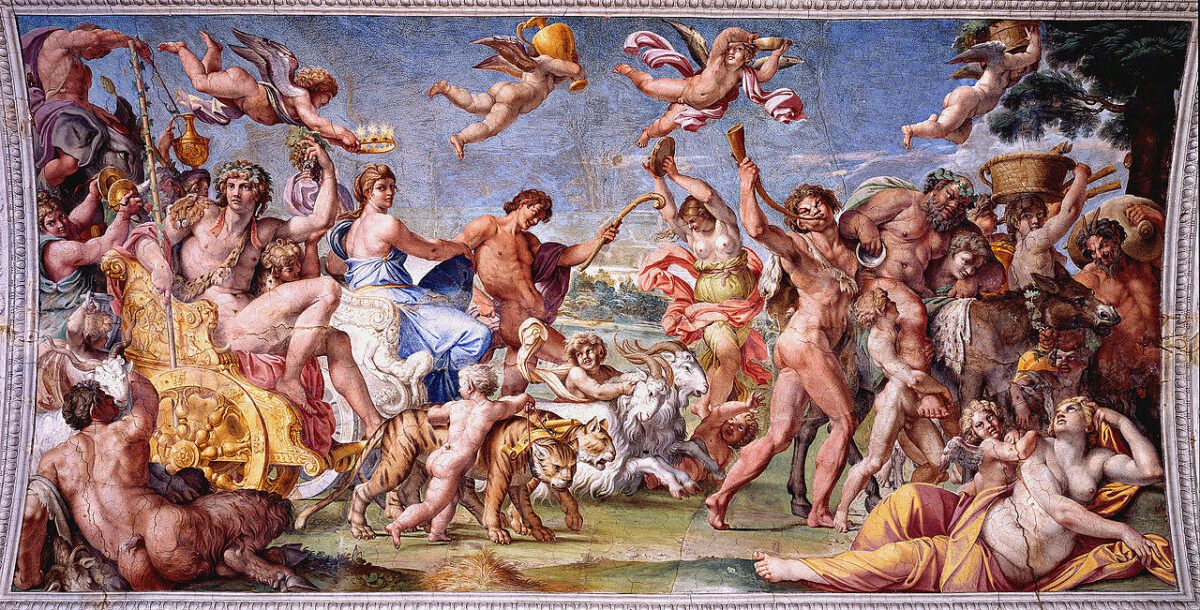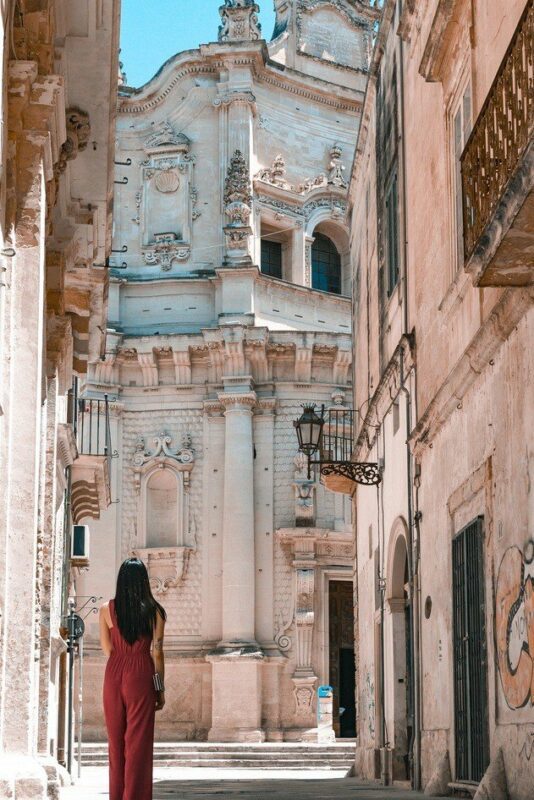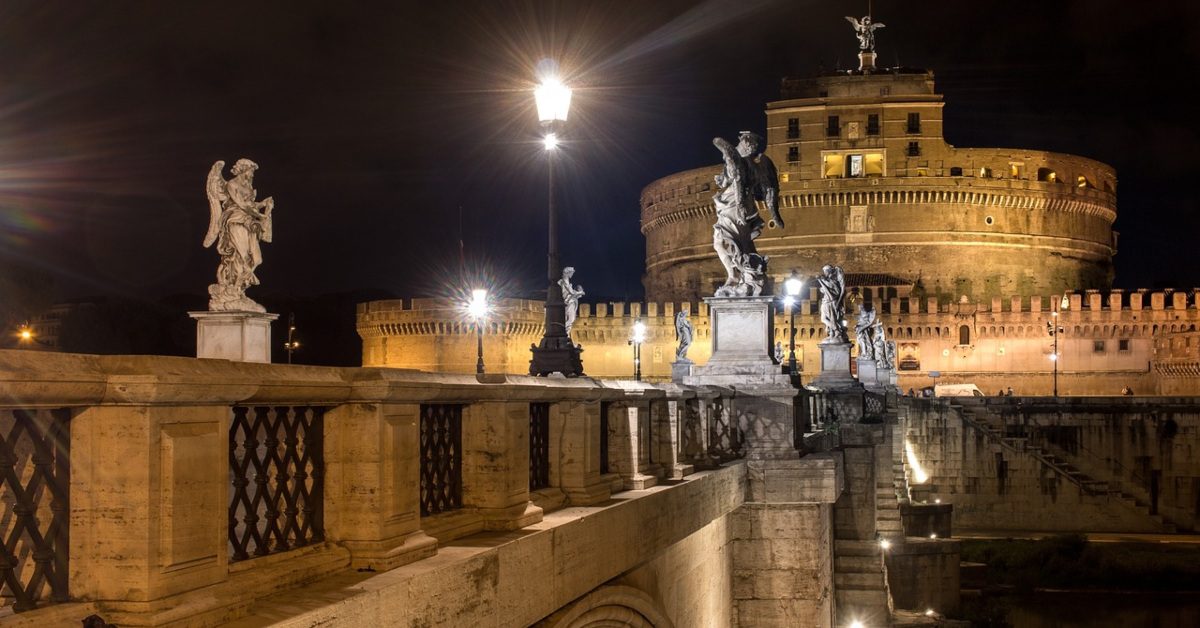Giacomo Puccini’s masterpiece, Tosca, takes place in Rome over the course of about 36 hours. Indeed, the opera has even been performed in real time at the actual locations within The Eternal City, such as the 1992 version starring Placido Domingo and Catherine Malfitano.
The opera is based on a French play, La Tosca, where the playwright described the exact dates and time of the action as taking place in the afternoon, evening, and early morning of June 17th and 18th, in the year 1800.
Rome in the Time of Tosca
Anyone who has traveled to Rome in the 21st century knows that the buildings which make up the setting of Tosca have not changed a lot in 200+ years. They can still be visited in very much the same state as they were when the sensuous singer Floria Tosca and her artist lover Caravadossi conspired to outwit their nemesis, Scarpia.
Let’s have a quick tour of these locations.

Act 1 – The Church of Sant’Andrea della Valle
The Church of Sant’Andrea della Valle is situated in the heart of modern Rome and still functions as a local parish. It’s considered a minor basilica in the Sant’Eustachio neighborhood, nowadays better known for its eponymous coffee bar.
The Attavanti chapel named in the libretto of Tosca, however, is fictitious. Its insertion into the plot was a creative invention to give importance to the character of Lady Attavanti, the “other model” for Cavaradossi’s Mary Magdalen. (From Recondita armonia, “And you, unknown beauty, crowned with blond hair…”)
Of note, the last chapel on the left in the furthest niche is a statue of Saint John the Baptist by Pietro Bernini, the father of the more famous Gianlorenzo Bernini, whose baroque masterpieces are scattered throughout the city’s squares and churches.
At the end of Act 1, the spotlight focuses on Scarpia, who reveals his lusty intentions of possessing Tosca, claiming that the alluring singer makes him forget even God. We then hear a haunting blend of his aria, Va’, Tosca mixed with the choir from the Church of Sant’Andrea della Valle chanting the Te Deum as the bells toll in the distance. One of the most ominous moments in all of opera.
Act 2 – Palazzo Farnese

credit: Wikicommons Media
Only a five or ten-minute walk from Sant’Andrea della Valle is Piazza Farnese and its famous Palazzo, which is now the seat for the French Embassy to Italy. As the name implies, it was designed for the important Farnese family in the 16th century. None other than Michelangelo himself was involved with the original architecture.
The artistic crown jewel of this building is a series of frescoes called, The Loves of the Gods (1608), by Annibale Carracci. They were painted at a time in Rome when two competing styles of artistic expression were emerging. Carracci championed a type of neo-classicism, not unlike the painters in the late Renaissance. Meanwhile, his crosstown rival, Caravaggio, was upending the art world with his ultra-realistic, gritty Baroque style.
In this same building is where we find Tosca, summoned to Scarpia’s apartment where he bribes and blackmails her into submitting to his carnal desires.
Our heroine agrees to his terms. Seemingly. But then she shows Scarpia what the kiss of Tosca truly tastes like!
Act 3 – Castel Sant’Angelo
Castel Sant’Angelo dates all the way back to the 2nd century, when it was originally called The Mausoleum of [Emperor] Hadrian, who commission the work as a burial chamber for himself and his family.
At the beginning of the 14th century, the papacy converted the structure to a fortress and prison. Nicholas III connected the castle to Saint Peter’s Basilica by way of a covered passage that would allow the popes to escape to the castle in the event that the Vatican would fall under siege.
This is where we encounter Cavaradossi in Act 3, as he awaits his sentence to be carried out; death by a firing squad. He begins to write a good-bye letter to Tosca, then sings an aria to their memories together. (E lucevan le stelle, “And the stars shone”).

Visit Italia, Prepare To Be Awed...
We want to show you the BEST of Italy, whatever that looks like for you!
From the ancient capital, in all its majestic splendor, to the sun-kissed coast where they celebrate great meals, relaxed strolls, and "the sweetness of doing nothing."
Tosca arrives with great news. She shows her lover the writ of safe-conduct signed by Scarpia, and divulges the plan where the executioners’ guns will be loaded with blanks. They start to dream about their life together away from Rome and their enemies where they can determine their own destiny.
Well, not all goes according to Tosca’s brilliant plan, unfortunately. This is a Puccini tragedy, after all, and happy endings are rare indeed.

Rome in the Time of Tosca
Beyond the genius of Puccini’s composition, what made this opera so appealing to its original audiences (the critics were less enamored) was that it spoke to a mood wafting around Italy at the time.
The plot and setting of Tosca resurfaced memories of the French Revolution, when all of Europe was dreaming of a free state, unbridled by monarchies or religious control.
By the time Puccini’s opera debuted in 1900, Italy had already achieved this, to some degree, through unification in 1861. Full unification came later, but some are convinced that it still has not been fully realized, as reflected in the words of Massimo d’Azeglio, who famously said, “L’Italia è fatta. Restano da fare gli italiani.” (“Italy has been made. Now it remains to make Italians.”)
Rome in the time of Tosca was the capital city of a country in transition. The protagonists, not unlike Italy itself, were looking to escape from the constraints of external controls and plot their own fate. But fate often has ideas of its own, sometimes with tragic consequences.

Beautiful photos and I enjoyed reading about Tosca. I am so looking forward to visiting Bella Italia once again. She is the love of my life.
Grazie, Filomena! And I think we’re all anxious to start traveling again. There seems to be some light at the end of the tunnel, so hopefully by summer! Ciao